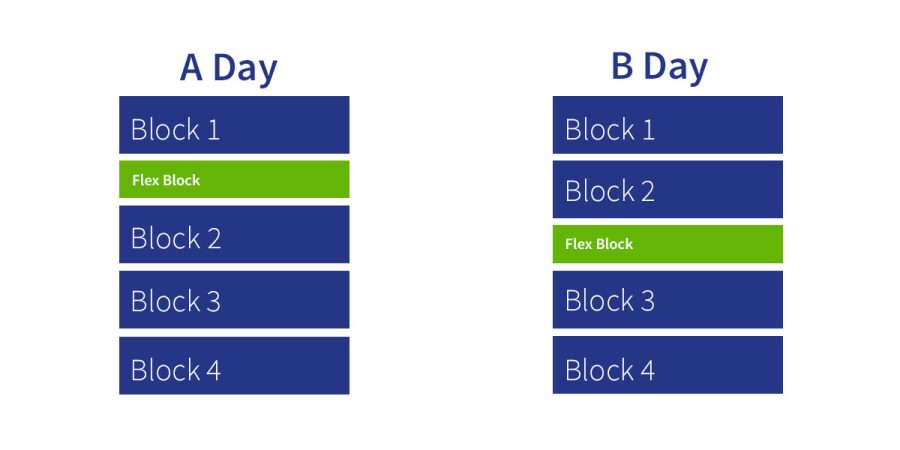Block Scheduling: An Outdated System
The issues with block scheduling and possible solutions
You sit in painstaking anticipation as you wait for the 90-minute period to end, already losing interest halfway through class. While in contrast, another student across the hall attempts to catch up on work after missing the only day of class the previous week.
As teens’ attention spans deteriorate more and more from rapidly developing technology, block scheduling becomes an increasing issue. There has already been concern in the past about how block scheduling is not efficient because of lack of attention, but it is now even more present.
According to time.com, humans now have a shorter attention span than goldfish. Additionally, the average 14-16 year old can only focus for 32-50 minutes as reported by CNLD Testing & Therapy. Based on the aforementioned statistics, 50-minute classes are ideal for teenagers, not the current structure.
The current way classes are structured makes it so half of students’ classes are on one day and the rest are on the other. This comes with some noticeable exceptions, such as career technical programs. The two separate blocks that are divided throughout the year are called A and B.
One issue with the current structure of classes is inefficiency. Staff members have to constantly remind and announce whether it’s a day A or day B. If there wasn’t this structure it would add peace of mind to the busy and complex schedule of most high school students.
However, the most jarring error of block scheduling is how it plugs in the leak of education excellence from pouring out, with only drops of shallow information being dumped onto the student each class.
“It can take longer to learn things in my classes,” junior Gina Strain said.
Not only is block scheduling worse for attention, but retention as well. Since students don’t have class every day it is hard to remember the information learned in the previous class.
“I feel like block scheduling causes a break in the learning process and doesn’t allow me to come to school everyday and learn the same material to build repetition,” senior Landon Angione said.
Another downside to block scheduling is that missing a single class on certain weeks can mean you miss half of the content that was reviewed the previous week.
“When absent you will most likely be behind everyone else in the next class,” sophomore Charlie Shaffer said.
An often overlooked, and crucial issue with block scheduling is lack of continuity. Similar to the information lost during summer break, having a block schedule causes students to lose knowledge.
“When I have choir only two to three days a week it makes it far more difficult to learn the complexities of a piece [of choral music],” sophomore John Polnik said.
Some believe that block scheduling allows more material to be covered, but this argument is illogical as when broken down to even a mathematical level it is false.
If you have three day A or B classes on a given week under the current process, you will at most be learning for 270 minutes. If you only have a class 2 days per week it drastically decreases to 180 minutes, compared to the reliability of period scheduling.
Under period scheduling, students have six or seven classes all year, each day of the week. If said classes are 50 minutes, then it allows students to learn 250 minutes per week, without constantly being interrupted by a flawed system of division.
This method also acts as a safeguard for snowdays, or other events that may halt the learning process for a day, as students will be guaranteed to have the same classes the next day.
Block scheduling disallows students to build repetition in classes, removes continuity from curriculum, causes collective confusion among the student body, is inefficient, statistically inferior and can be devastating to an individual’s education.
With all this said, why was block scheduling even implemented?
The general consensus is that this system would relieve the workload of teachers and students alike, but higher grade point averages can be deceptive of actual academic success.
But don’t take an article’s word, take the man’s instead. According to U.S. Department of Education “Nationally, schools following 4×4 block schedules (90 minute classes that meet daily for one semester) were found to have mathematics achievement scores two-thirds of one grade-level lower than schools following 50-minute year-long mathematics courses”
Nonetheless, in contemporary times it has become the American standard to replace greatness with convenience. Indeed, having 2 days to complete 1 paper of homework is comforting.
Instead of challenging the minds of our nation’s youth, and preparing them to have the time management skills necessary for the workforce, we are protecting procrastination and letting it bloom in a garden of ignorance.
Our generation’s minds can be a beautiful rose bush if watered properly, however under block scheduling, students are growing thorns to ‘block’ out their true potential from sprouting.
Your donation will support the student journalists of GlenOak High School. Your contribution will allow us to purchase equipment and cover our annual website hosting costs.

Sean Saunders is a Senior at GlenOak this year. This will be his third year on staff. Sean is involved in Concert Choir, Chorale, and Men’s Chorus in...






